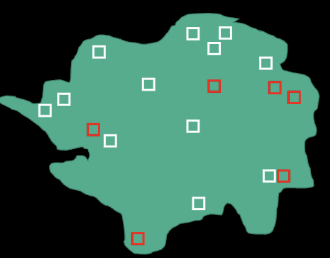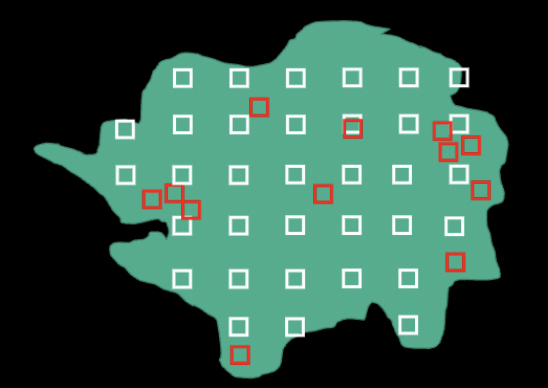#10 Habitat Selection IV
1/53
There's no tags or description
Looks like no tags are added yet.
Name | Mastery | Learn | Test | Matching | Spaced |
|---|
No study sessions yet.
54 Terms
What are 2 types of models used in ecology, especially in habitat selection studies?
RSPF = Resource Selection Probability Function
RSF = Resource Selection Function
RSPFs
estimates the actual probability of selecting a resource or habitat type
Generate an idea of the probability a certain area will be used in a certain time-frame
What does RSPFs do?
Randomly/systematically sample points across a habitat of interest
Record presence/absence (or whatever qualifies as ‘use’ in your study)
What do RSPFs usually require
random sampling of available points and design-based sampling assumptions
What is the main thing about RSPFs?
wants to offer a specific number that this resource has a certain likelihood of use
When would you use a RSPFs?
You have data on used vs. available habitat
You want to model relative selection
You don't have strong sampling control

Which function is this?
RSPF
RSF
a model that estimates the relative probability that an animal will use a certain habitat or resource based on its characteristics
What function do you use when asked this question: Given what's available, which resources or habitat features does the animal prefer to use more often?
RSFs
What is the first step in a RSF?
Collect known use points (usually through prior survey), then randomly or systematically sample all available habitat
Sites of known use/occupancy
What is the second step in a RSF?
background availability
availability across the whole landscape
Compare use vs availability
Creates an index of relative selection
What appears preferable/avoidable
What is the main thing about RSFs?
Want to say
These animals appear to select for these habitats and avoid these ones
Relative signals and selection preferences
When do you use an RSF?
You have a rigorous sampling design
You want to estimate actual probabilities
You're doing management or conservation planning that needs real use probabilities
Which of the two functions is a more common approach?
RSFs

Which model does this represent the most?
RSF
Why is behavioral considerations important?
In addition to “state”, behavioral decision making plays a role in habitat selection
Habitat selection is not always just a question of finding the fundamentally ‘best’ habitat and going there
More useful to look at behavioral side of things and not habitat
Best might not always be the one to select
What 3 ways can behavioral habitat preferences arise in?
“Innate”; genetic, heritable
Imprinted
Learned
Heritable/innate preferences (hard-coded genetically)
Solid consistent preferences regardless of preferences and other factors
Natural selection will favor a more reliable cue => more advantageous to always go for the cue
selection regardless of experiences
Often strongly related to proximate cues
Imprinted preferences
Preference becomes set, often at a critical period
Juvenile stage when they learn certain habitat preferences and then they become hardcoded afterwards
Less flexible to change preference
Learned preferences (flexible)
Learn habitat preferences from conspecifics
Often parents to offspring
More common in species with high offspring investment
Bigger brain = more flexible in preference
What can Learned preferences (flexible) also be from?
self or non-relatives
Other individuals will watch others to see if that action is preferable
High parental care
More learned preferences
Share habitat preferences
How can Conspecifics of social groups be good?
Use to look for good social opportunities
Mating opportunities
Potential resources
Many eyes/dilution effects
Information sharing
How can Conspecifics of social groups be bad?
Intraspecies competition
for food/ mates
Territoriality
Monopoly on the territory
Disease
Attract predators
Cannibalism
Near-complete niche overlap
What is a general rule for how Conspecifics of social groups can be bad?
the more vulnerable you are (ex: prey species), the more likely you are to be attracted to conspecifics!
Predators might not benefit from conspecifics
Avoid factor
What are the 2 types of distribution to assess quality?
IFD→ Ideal Free Distribution
IDD→ Ideal despotic distribution
Ideal Free Distribution
How animal density relates to the quality of the habitat
Occupy the best habitat until it becomes so crowded that the next best habitat is better
What happens when a habitat becomes overcrowded?
Animals will “ideally” distribute themselves proportionately across habitats of different quality so that individual fitness is equal
What is the idea about habitat selection that Fretwell and Lucas came up with?
when you switch habitat it relates to the relative quality and relationship between density and individual benefit
When the individual benefit equalizes with the benefit of the second habitat, they will switch, and so on
What happens when the distribution between two habitats is equal?
both habitats equal out with the amount of benefit per individual→ amount of individuals in their habitat will balance out
Animals will distribute themselves proportionally to the quality of habitat
What are the rules about Ideal Free Distribution?
Some variation in habitat quality
Animals always act to maximize fitness (“optimality”)
What are some Assumptions about Ideal Free Distribution?
Scramble/exploitation competition only
Animals have complete knowledge of all available habitats (ideal)
All habitats equally accessible, free dispersal
Increasing density is negatively related with fitness
What is the assumption about Scramble/exploitation competition only?
Assuming no animals are being territorial
They are equaly capable they can all scrabble for the resources
What are some Predictions about Ideal Free Distribution?
When habitats are full, fitness of individuals is equal in all habitats
Regardless of quality
Habitats with the highest densities have highest fundamental/inherent habitat quality
Hold the most animals
Is every competitor equal?
No
Monopolize limited resources
Exclude competitors
“Ideal Despotic” distribution
“Ideal Despotic” distribution
Actively exclude competitors from coming in and destroying your good habitat
What are the rules for Ideal despotic distribution?
Some variation in habitat quality
Animals always act to maximize fitness
What are the assumptions for Ideal despotic distribution?
Animals have complete knowledge of all habitats (ideal)
Behaviorally dominant individuals secure resources via interference competition (despots)
Increasing conspecific density is negatively correlated with fitness
Subordinates pay disproportionate costs for competing with despots
What does the Ideal despotic distribution do instead of Scramble/exploitation competition?
Behaviorally dominant individuals will push out other competitors
instead of scramble
What are the predictions for Ideal despotic distribution?
Fitness of individuals is unequal in all habitats
Density not always correlated with habitat quality/fitness
Strongest occurs in the best quality habitat only
monopolize the habitat
Why does Ideal despotic distribution have the assumption that fitness of individuals is unequal in all habitats?
dominant individuals who settle in habitats with the highest fundamental quality→ obtain highest fitness
How can we use IFD/IDD to assess quality?
IFD: Best habitats have the highest densities of individuals
IDD: Best habitats have the most dominant individuals
What is one way to test how IFD and IDD assess quality?
Removal experiments
Remove some individuals (or alter patch profitability) and observe response in distribution
Test where individuals are removed to study redistribution
What are some factors that affect IFD/IDD?
Scale
heterospecifics
Juvenile dispersal
Sex-biased dispersal
What is the order in which habitats are colonized by newly-arriving individuals?
True novel colonization
Returning migrants
Dispersers
True novel colonizers
first to occupy a new area
Returning migrants
come back to previous breeding sites
Dispersers
move from natal or previous territories to new areas
Intraguild Predation
Predation between competing species that use similar resources
What example shows animals avoiding areas due to intraguild predation?
Eurasian Pygmy Owls avoid nesting near Boreal Owls—a larger, competing species
showing how intraguild predation affects distribution
How can scale influence habitat selection patterns?
distribution mechanisms differ across spatial scales
larger scales (e.g., home range), animals may follow IFD patterns.
At smaller scales (e.g., microhabitats within home ranges), competition may create despotic patterns (IDD)
Can heterospecifics (different species) influence habitat selection?
Yes
Some species are more likely to co-occur even after controlling for habitat characteristics
This suggests positive attraction (e.g., for safety, resource cues, etc.).
Juvenile dispersal
Disperse from natal site to avoid being outcompeted by older, more-established conspecifics
Also avoids inbreeding and competition with close relatives
What is Sex-biased dispersal?
occurs when one sex disperses more frequently than the other
varies depending on whether mate competition or resource competition most limits fitness
What are some other factors that affect IFD/IDD?
Risk (predation)
Disease/parasitism
Sampling and cognitive ability
Reliability and stability of habitat cues
Habitat selection is COMPLEX!